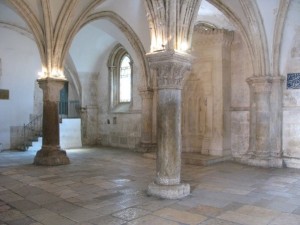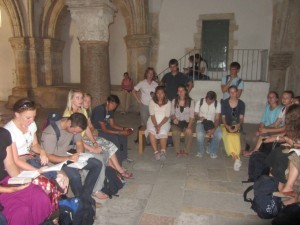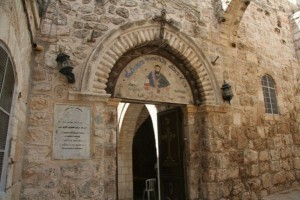by Eric D. Huntsman
All four Gospels agree that on the last night of his mortal life, Jesus shared a special meal with his closest disciples in an upper room in Jerusalem. Described as a large, well-furnished room, it was probably in one of the larger houses in the upper city, a wealthy area now known as Mount Zion.

The Cenacle (from the Latin cenaculum, for “dinner), the traditional Catholic site of the Last Supper
The Twelve are specifically mentioned as being present (Matthew 26:20; Mark 14:17; Luke 22:14), although perhaps others might have been there too.
John differs from the other gospels, however, in the timing of the dinner: while the Synoptic Gospels make it clear that the Last Supper was a Passover meal (Matthew 26:17, 19; Mark 14:12, 14–16; Luke 22:7–6, 11–15), John actually maintains that the Passover began at sunset the next day, the day when Jesus was crucified (John 13:1; 18:28, 39; 19:31, 42). Jewish tradition also supports this later dating: the Babylonian Talmud claims that “on the eve of Passover, Yeshua was hanged” (Sanhedrin 43a). Indeed, John’s dating bears more historical verisimilitude since it is unlikely that Jesus—or anyone—would have been seized, tried, and executed on a holy day, something the chief priests had earlier insisted they wanted to avoid (Matthew 26:5; Mark 14:2).
Efforts have been made to resolve this discrepancy, appealing, among other things, to the possible use of different calendars by the various Jewish groups that existed in the first century A.D.[1] In the end, however, suspending judgment on which is “correct” and looking separately at symbolic and theological intents of the different gospels seems like the best approach. Seeing the Last Supper as a Passover meal is important while reading the Synoptic gospels because of their accounts of the institution of the sacrament, which incorporates and fulfills important Passover imagery. On the other hand, the Passover imagery used by John is also powerful: the next day was the preparation day before the Passover began at sunset, and between 3:00–5:00 the paschal lambs were slaughtered in the Temple.[2] Thus Jesus died on the cross at 3:00 p.m., the very moment the first Passover lamb was sacrificed. Still a possible reconciliation might be found in a statement by Luke: “With desire I have desired to eat this passover with you before I suffer: For I say unto you, I will not any more eat thereof, until it be fulfilled in the kingdom of God” (Luke 22:14–16; see also Matthew 26:18, D&C 27:5ff.). This urgency, to my mind at least, suggests the possibility that Jesus, knowing that he would be dead and buried by the time the formal Passover actually began the next evening, was anxious to celebrate this important holiday with his friends. In advance of the actual holiday, he might have performed as much of the ritual as possible to show how its symbolism would be fulfilled the next day. Interestingly, the preserved accounts lack any mention of lamb meat, which would have needed to come from a sacrifice in the temple and could not be done in advance.
[1]See the arguments summarized by David Rolph Seely, “The Last Supper according to Matthew, Mark, and Luke,” From the Last Supper to the Resurrection (Salt Lake City: Deseret Book, 2003), 64–74, and Jeffrey R. Chadwick, “Dating the Death of Jesus Christ,” BYU Studies Quarterly 54, no. 4 (2015): 135-191.
[2]Josephus, Wars of the Jews 6.9.3, §422–427.



